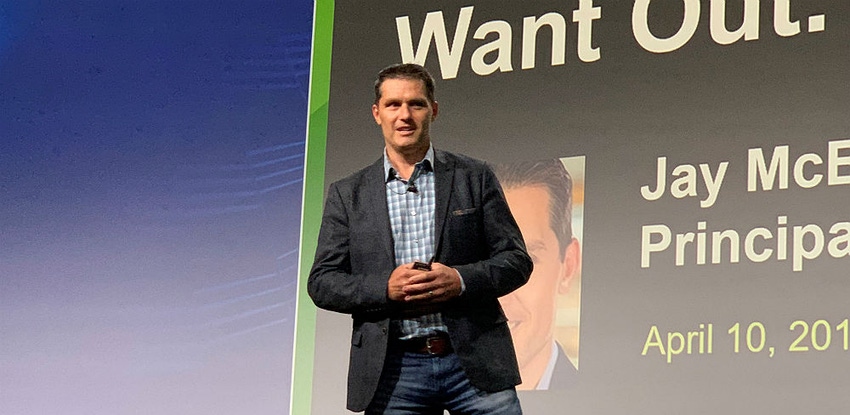Some market forces are challenging, but specializing will make you strong.

(Pictured above: Forrester’s Jay McBain on stage at the Channel Partners Conference & Expo, April 10.)
CHANNEL PARTNERS CONFERENCE & EXPO — Growth in U.S. GDP is strong. Hardware spending is even better. Investments in IoT, artificial intelligence and other new technologies are off the charts. So why are so many partner businesses – and particularly MSPs – considering throwing in the towel?
Jay McBain, principal analyst, global channels, Forrester Research, took to the keynote stage to answer those questions in session dubbed, “70% of Your Peers Want Out — Why?“, April 10, at the Channel Partners Conference & Expo in Las Vegas.
A handful of trends are responsible for so many channel-partner companies looking for potential buyers of their businesses. The first is the changing nature of the buyer — notably the impact that the line-of-business (LOB) buyer is having on technology-purchasing decisions.
“This new buyer, the LOB executive, has a different psychology and behavior. They have a different buyer’s journey,” McBain told the packed conference hall, noting that 65% of tech-buying decisions are now made by these executives. Almost three in four LOB buyers go straight to the web to find a technology provider.
The channel itself, of course, is changing too. There are 36% fewer IT channel firms now than there were in 2008. Forty percent of channel business owners plan to retire by 2024, and the expectation from just a few years ago that millennials would take their place has not come to fruition.
“The average profit margin now is 17%,” McBain said. “A quarter of MSPs around the world are losing money … if you’re the average MSP, you are averaging break-even margins.”
Ninety-six percent of partner businesses aren’t growing beyond 10 employees.
Also impacting partners’ businesses are the growing number of subscription services in every industry and the increasing number of nontraditional partners such as digital agencies entering the market.
Another big trend is the impact of marketplaces and how they are accelerating resell’s decline.
“These [marketplaces] don’t just wrap together the software, but also the services and the consulting … they are meeting the buyers in terms of their preferences,” said McBain.
But the business landscape isn’t so bleak for the partner business that makes adjustments. One tip from McBain is to take a long hard look at the customer.
“Look at your own company, but look at your buyer.,” said McBain. “Try to figure out if there are pockets of opportunity you could add value to, [even] if you don’t own the whole project.”
Also, codify your intellectual property. And don’t just specialize. Specialize within your specialty.
“Stop being a health-care expert and start being someone focused on a certain-sized clinic,” McBain said, adding that you can drill down even more, going two or three layers deeper to get even more ingrained in a specific vertical.
A changing channel means changing your approach to business. Be aggressive and be focused.
“It’s no longer just hanging up a shingle; it’s declaring the pieces of the market where you’re going to get 80% share and going and taking it,” McBain said.
About the Author(s)
You May Also Like


